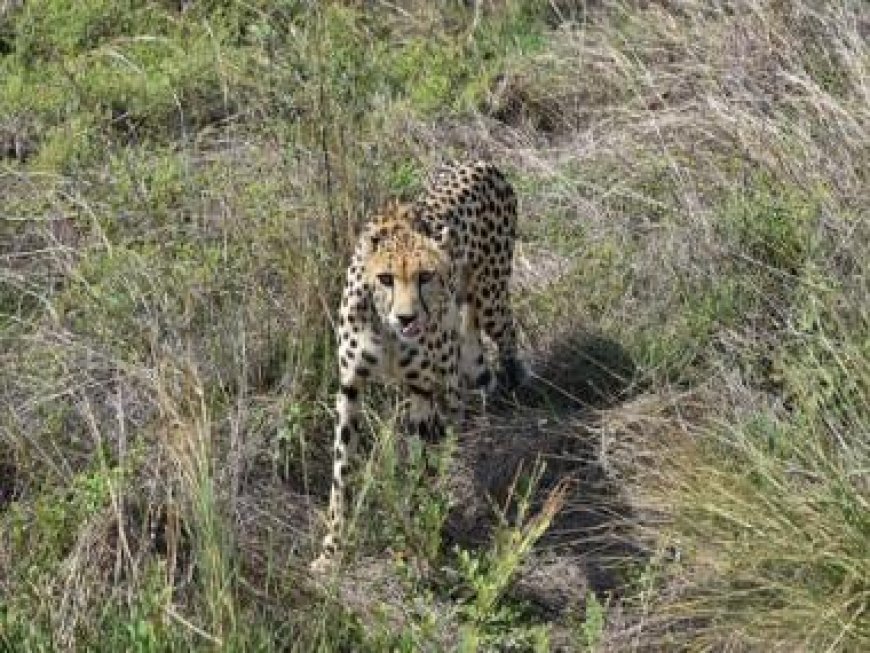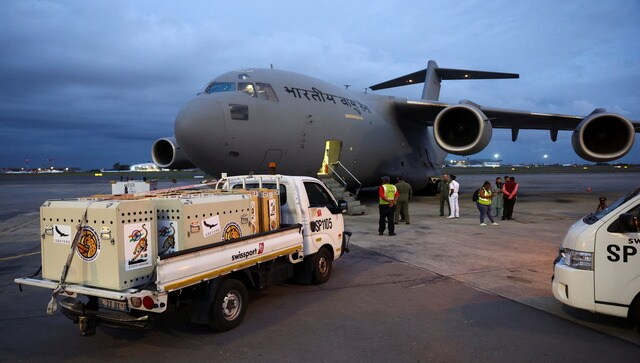A year after reintroduction of cheetahs in India, a look at how big cats have fared
A year after reintroduction of cheetahs in India, a look at how big cats have fared

Today (17 September) marks one year of cheetahs’ comeback in India. Last year, Prime Minister Narendra Modi on his birthday released the first batch of eight Namibian cheetahs in Madhya Pradesh’s Kuno National Park (KNP). This was the first intercontinental translocation of big cats into India.
India got another 12 wild cats from South Africa in February this year as part of the Project Cheetah. Under the ambitious initiative, the Centre wants to bring around 5-10 cheetahs every year to the country over the next decade with the aim of establishing a viable population of about 35 cheetahs.
A long wait is over, the Cheetahs have a home in India at the Kuno National Park. pic.twitter.com/8FqZAOi62F
— Narendra Modi (@narendramodi) September 17, 2022
As the cheetahs complete one year in India, let’s take a look at how they have fared so far.
Nine dead, 15 cheetahs go on
India has translocated 20 cheetahs from Africa since last September. Four cubs were born to a Namibian pair at Kuno in March.
By June, six cheetahs, including three cubs, died. Namibia-based Cheetah Conservation Fund (CCF), which is involved in the reintroduction of the animals in India, said at the time that the project was progressing better than anticipated before the translocation.
“It’s too early to label Project Cheetah a success. But, so far, the cheetahs have shown every ability to survive in India. There’s a long road ahead and there will be more setbacks, but from the perspective of the longest-running cheetah conservation project in Africa, the CCF considers things in India are moving well,” news agency PTI quoted the CCF as saying.
After the first six deaths in three months, Union environment minister Bhupender Yadav said that “we take responsibility for whatever happened”, but asserted that Project Cheetah will be a big success, as per the news agency.

In July, two adult male cheetahs, Suraj and Tejas, died back to back. Another death of a feline was reported in early August, taking the total cheetah casualties to nine.
This death toll includes four of the 12 South African cheetahs that were translocated in February. Among the founding population that came from Namibia, two are no more.
So far, 14 adult cheetahs and one cub have survived.
No cheetahs have died due to risk factors accounted for in the Cheetah Action Plan 2022, reported Indian Express. The plan, which estimates 50 per cent mortality after cheetahs are released in the wild, mentions deaths due to territorial fights, conflict with competing predators, human-animal interaction and natural causes, noted Mongabay-India.
ALSO READ: Ninth cheetah dies: What is killing the wild cats in Madhya Pradesh’s Kuno?
Two ‘unfit’ for the wild
As per an Indian Express report, three Namibian cheetahs, which were part of the batch of eight brought to India last September, had been raised in captivity in the African nation. While one of them died of kidney failure, the two others are kept inside bomas (enclosures) as “breeding females”.
These two female cats, Jwala and Nabha, have not been released in the wild at Kuno. It was Jwala who gave birth to four cubs, out of which only one remains.
Row over radio collars
After the two deaths in July, multiple reports blamed satellite collars, which are gadgets put around the necks of cheetahs to track and monitor their movements, for causing infections in the animals.
According to The Hindu report, veterinarians who examined Suraj found a wound on his neck, infected with maggots and its larvae.
However, the environment ministry dismissed the reports of cheetah deaths linked to radio collars as “hearsay” and “speculation”.
Speaking to Mongabay-India in August, experts pointed out that different weather patterns in Africa and India could have played a role in the “poor survival rate” of the cheetahs.
While Namibia and South Africa are drier countries, Madhya Pradesh is known for heavy monsoons. As per the report in the web portal, cheetahs were in thick winter coats when they were translocated to India (which lies in the Northern Hemisphere) as it was winter in the Southern Hemisphere then.
YV Jhala, former dean of the Wildlife Institute of India (WII), told Mongabay-India that veterinarians in Kuno were unprepared for cheetahs being infected by maggots.
Although radio collars were not the “main problem”, the cheetahs were unable to lick themselves clean as the collars posed obstruction, leading to the festering of bacteria and maggots, Jhala explained.
“It seems that the thick neck hair on the cheetahs (possibly due to the absence of moulting) combined with the high rainfall and humidity keeping the fur wet and finally the high parasite loads (particularly ticks) are all contributing to the problem,” a cheetah expert from South Africa was quoted as saying by Mongabay-India.
Another expert agreed that “radio collars are not the underlying reason” for the deaths of the cheetahs. Ravi Chellam, a wildlife biologist and Coordinator of Biodiversity Collaborative, told Mongabay-India that it needs to be probed if African cheetahs are vulnerable to some parasites and insects in India and whether collars provide a conducive “micro-environment” for these to thrive.
Notably, radio collars were later removed from the free-ranging cheetahs by early August. In a post on X, formerly Twitter, the CCF said, “We have removed collars from the rest of the cheetahs while we develop and test a better collar material for their monitoring devices.”
We have removed collars from the rest of the cheetahs while we develop and test a better collar material for their monitoring devices. Two females are still out; we are working to bring them back for comprehensive health assessments and any necessary treatments.
— Cheetah Conservation Fund (@CCFCheetah) August 3, 2023
Meanwhile, the head of Project Cheetah, SP Yadav, reiterated that no cheetah died due to radio collars. Speaking to ANI recently, he said, “There is no truth that any cheetah died due to radio collars. I want to say that monitoring is not possible in the wild without radio collars.”
Yadav also attributed the death of three cubs born at Kuno to “climatic factors”. “Generally, in other countries, poaching and hunting leads to deaths but our preparation was so good that not even a single cheetah has died due to hunting, poaching, or poisoning.. nor has any cheetah died due to human conflict..we have successfully achieved milestones in the past year,” he told ANI.
‘Aasha’ brings hope for Project Cheetah
Not all is gloom and doom though.
Namibian cheetah Aasha has explored her new landscape and adapted to the environment, as per a newsletter by Kuno authorities. She was released into the wild in March and has since travelled 200 km away from the KNP boundary, as per the newspaper Deccan Chronicle (DC).
“Aasha’s journey, thus far, in her new habitat is very exciting and adventurous, typical of a wild cheetah”, a forest officer in Kuno told the English newspaper.
“Aasha has carried herself in such a manner in the last one year that gives lots of hope for the successful introduction and establishment of cheetahs in India”, DC quoted the KNP newsletter as saying.
So, can we say Project Cheetah is a success or not? We will have to wait before attaching labels. As Madhya Pradesh Principal Chief Conservator of Forests, Asim Shrivastava, told Mongabay-India,” We need to give the project at least three to five years before reaching a conclusion”.
Speaking to BBC in August, Laurie Marker, executive director of CCF, said “detailed and close monitoring” is the key to Project Cheetah’s success. She said that “closer and faster communication could really assist the success of the project” and that “these are all measures being taken now”.
With inputs from agencies
What's Your Reaction?


























































